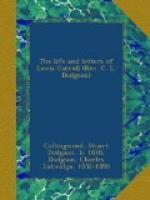receiving a second and larger one from the hands
of a benignant Russian peasant. The language
of hieroglyphics succeeded where all other means
had failed, and we returned to St. Petersburg
with the humiliating knowledge that our standard
of civilisation was now reduced to the level of ancient
Nineveh.
[Illustration: Instance of hieroglyphic writing of the date MDCCCLXVII—Interpretation. “There is a coat here, left in the care of a Russian peasant, which I should be glad to receive from him.”]
At Warsaw they made a short stay, putting up at the Hotel d’Angleterre:—
Our passage is inhabited by a tall and very friendly grey-hound, who walks in whenever the door is opened for a second or two, and who for some time threatened to make the labour of the servant, who was bringing water for a bath, of no effect, by drinking up the water as fast as it was brought.
From Warsaw they went on to Leipzig, and thence to Giessen, where they arrived on September 4th.
We moved on to Giessen, and put up at the “Rappe Hotel” for the night, and ordered an early breakfast of an obliging waiter who talked English. “Coffee!” he exclaimed delightedly, catching at the word as if it were a really original idea, “Ah, coffee—very nice—and eggs? Ham with your eggs? Very nice—” “If we can have it broiled,” I said. “Boiled?” the waiter repeated, with an incredulous smile. “No, not boiled,” I explained—“broiled.” The waiter put aside this distinction as trivial, “Yes, yes, ham,” he repeated, reverting to his favourite idea. “Yes, ham,” I said, “but how cooked?” “Yes, yes, how cooked,” the waiter replied, with the careless air of one who assents to a proposition more from good nature than from a real conviction of its truth.
Sept. 5th.—At midday we reached Ems, after a journey eventless, but through a very interesting country—valleys winding away in all directions among hills clothed with trees to the very top, and white villages nestling away wherever there was a comfortable corner to hide in. The trees were so small, so uniform in colour, and so continuous, that they gave to the more distant hills something of the effect of banks covered with moss. The really unique feature of the scenery was the way in which the old castles seemed to grow, rather than to have been built, on the tops of the rocky promontories that showed their heads here and there among the trees. I have never seen architecture that seemed so entirely in harmony with the spirit of the place. By some subtle instinct the old architects seem to have chosen both form and colour, the grouping of the towers with their pointed spires, and the two neutral tints, light grey and brown, on the walls and roof, so as to produce buildings which look as naturally fitted to the spot as the heath or the harebells. And, like the flowers and the rocks, they seemed instinct with no other meaning than rest and silence.
And with these beautiful words my extracts from the Diary may well conclude. Lewis Carroll’s mind was completely at one with Nature, and in her pleasant places of calm and infinite repose he sought his rest—and has found it.




